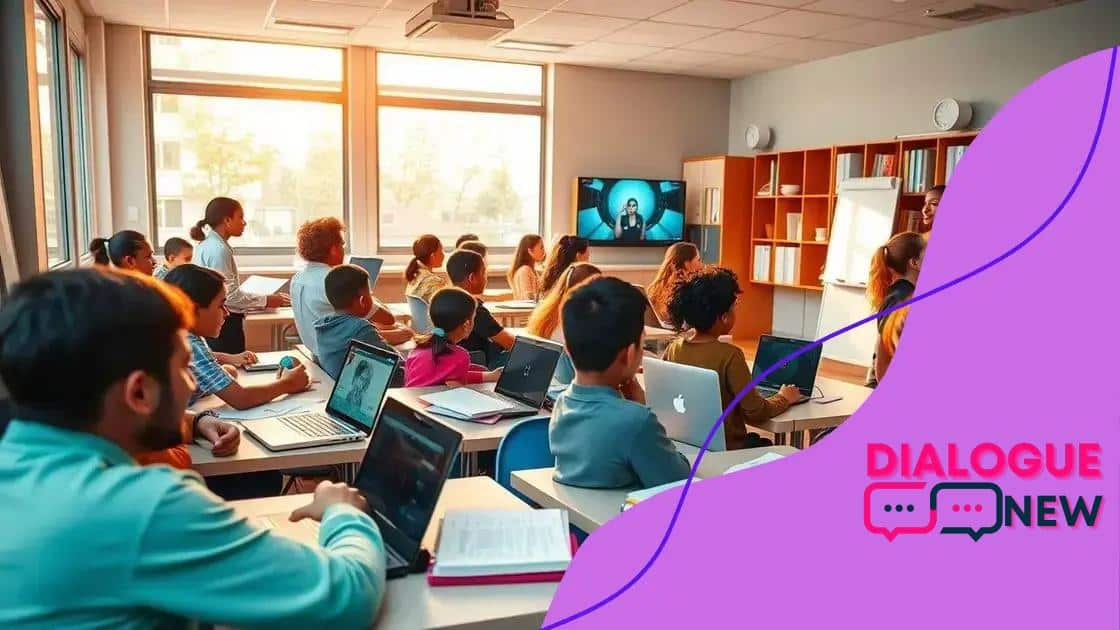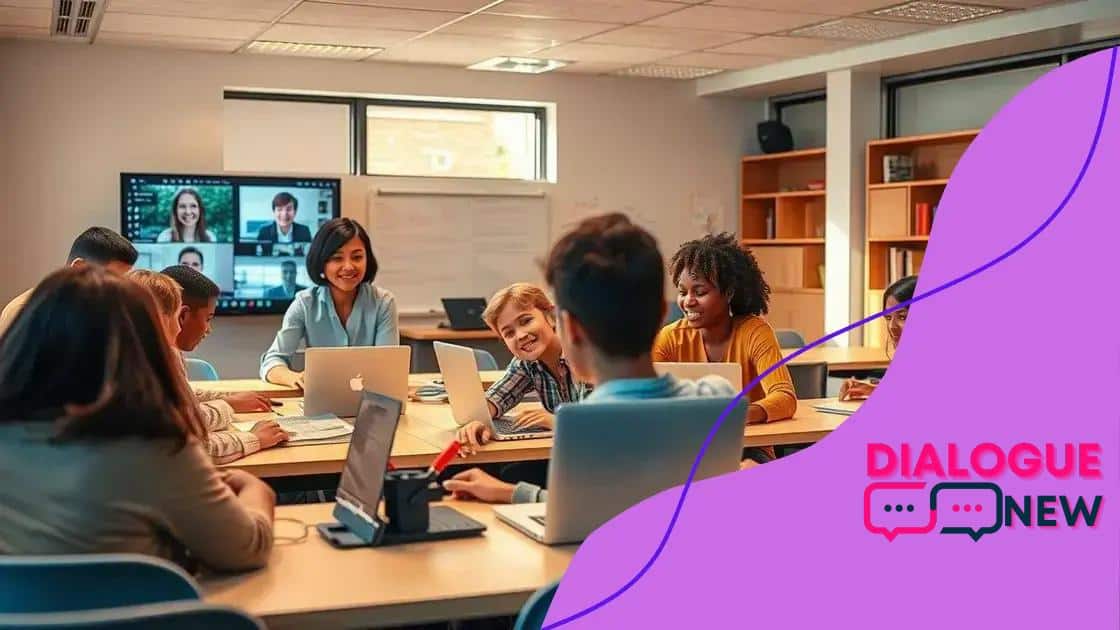Hybrid learning models for post-pandemic education

Hybrid learning models combine traditional classroom instruction with online education, offering flexibility, personalized learning experiences, and the integration of technology to enhance student engagement and accessibility.
Hybrid learning models for post-pandemic education have emerged as effective solutions, blending traditional and online methods. Have you wondered how this approach enhances learning experiences?
Understanding hybrid learning models
Understanding hybrid learning models is essential in today’s evolving educational landscape. These models combine traditional face-to-face teaching with online learning, creating a flexible environment for students.
What are Hybrid Learning Models?
Hybrid learning models integrate in-person and virtual instruction. This means students can learn from home while still participating in classroom activities. For many, this approach has improved access to education.
Benefits of Hybrid Learning
There are numerous advantages to adopting hybrid learning. Some key benefits include:
- Greater flexibility in learning schedules
- Personalized learning experiences
- Access to diverse resources and technologies
Additionally, students often report increased engagement when they can switch between online and in-person formats. This flexibility caters to various learning styles, making education more inclusive. Moreover, teachers can enhance their methods by incorporating technology, which can lead to better learning outcomes.
Key Components of Hybrid Learning
For successful implementation, certain components are vital. These include:
- Effective communication tools
- Curation of online content
- Regular feedback from students
Implementing these components ensures that students receive continuous support and clear expectations, maintaining motivation in both settings. As educational models continue to evolve, hybrid learning stands out by meeting the needs of diverse learners.
In conclusion, hybrid learning models represent a significant shift in education, offering flexibility and accessibility. By blending different teaching methods, educators can better cater to individual needs, ultimately fostering a more effective learning environment.
Key benefits of hybrid education
The key benefits of hybrid education lie in its ability to cater to diverse learning needs. This educational model combines traditional teaching with modern technology, making it versatile and effective.
Flexibility in Learning
One of the main advantages is the flexibility it offers. Students can choose when and where they learn, which accommodates different lifestyles and commitments. This makes it easier for learners to balance studies with other responsibilities.
Personalized Learning Experience
Hybrid education allows for personalized learning paths. Teachers can tailor their instruction based on each student’s strengths and weaknesses. This individualized approach often leads to better engagement and understanding of the material.
- Increased student engagement: Students tend to be more involved when they have control over their learning environment.
- Access to diverse resources: Online platforms offer a wealth of learning materials, enhancing the educational experience.
- Collaboration opportunities: Hybrid models encourage collaboration among students, fostering teamwork skills.
By incorporating various teaching methods, educators can help students build critical skills that will serve them in their future careers. Additionally, hybrid education can improve overall learning outcomes and satisfaction, as students feel more connected to their education.
Development of Digital Skills
Another benefit is the development of essential digital skills. Students become proficient in using various online tools and platforms, preparing them for a technology-driven world. This competency is crucial, as many careers require a strong understanding of digital environments.
In summary, the advantages of hybrid education are numerous and impactful. By blending traditional methods with innovative technology, this approach creates a rich learning experience that caters to the needs of today’s students.
Challenges in implementing hybrid models

The challenges in implementing hybrid models can affect both teachers and students. While this educational approach offers many benefits, it also comes with unique difficulties. Understanding these challenges is crucial for effective implementation.
Technical Issues
One major challenge is dealing with technical issues. Not all students have access to reliable internet or devices, which can create inequities in learning. Additionally, technical difficulties during online lessons can disrupt the learning process.
Training Educators
Another significant hurdle is training educators to adapt to this new model. Many teachers may not be familiar with online teaching tools or hybrid teaching strategies. Providing adequate training and resources is essential to ensure they feel confident in delivering lessons effectively.
- Time constraints: Teachers often need to create both in-person and online content, requiring more planning.
- Classroom management: Balancing attention between in-person and online students can be challenging.
- Adapting curriculum: Existing curriculums may not fit well with hybrid formats, leading to confusion.
Furthermore, student engagement can vary. Some students thrive in a hybrid model, while others may struggle. Teachers must find ways to keep all students motivated, regardless of their learning environment. This need for engagement can lead to increased workload and stress for educators.
Equity in Education
Equity is another pressing issue. When implementing hybrid models, schools must ensure that all students have equal opportunities to learn. Schools in affluent areas may have more resources than those in low-income neighborhoods, which can widen the educational gap.
Ultimately, the transition to hybrid education presents several challenges that require thoughtful solutions. By addressing these challenges, schools can create a more effective and equitable learning environment for all students.
Best practices for educators
Understanding the best practices for educators in a hybrid learning environment is essential for success. These practices can help create a more effective, engaging, and inclusive learning experience for all students.
Creating an Engaging Curriculum
One of the first steps is to design an engaging and flexible curriculum. This means integrating various teaching methods that cater to both in-person and online students. Using multimedia resources, such as videos and interactive quizzes, can help keep students interested and involved in their education.
Utilizing Technology Effectively
Educators should become adept at using technology to enhance learning. Familiarizing themselves with digital tools and platforms allows teachers to create a more interactive experience. Video conferencing tools, learning management systems, and collaborative apps can facilitate communication between teachers and students.
- Encourage participation: Use tools like polls or breakout rooms to involve students during lessons.
- Provide timely feedback: Regular feedback helps students stay on track and feel supported.
- Record lessons: Providing recorded sessions allows students to review material at their own pace.
In addition to these practices, establishing clear expectations is crucial. By setting guidelines for communication and participation, educators can create a structured learning environment that works for everyone. This approach helps students understand what is expected of them, whether they are attending in person or online.
Building Relationships
Building rapport with students is also vital in a hybrid setting. Making personal connections fosters a supportive environment where students feel comfortable participating. Teachers can check in with students individually to better understand their needs and challenges. This personal touch can make a significant difference in student engagement.
Finally, continuous professional development is key. Educators should seek out resources and training opportunities to improve their hybrid teaching skills. This commitment to growth not only enhances their teaching practices but also positively impacts student learning experiences.
Future trends in hybrid learning
Examining the future trends in hybrid learning reveals exciting possibilities for education. As technology evolves, so do methods of teaching and learning. Educators are increasingly adopting innovations that enhance the learning experience.
Increased Use of Artificial Intelligence
One major trend is the integration of artificial intelligence (AI). AI tools can assist in personalizing learning experiences based on individual student needs. By analyzing student performance, AI can help educators create tailored lesson plans. This level of customization makes learning more effective and engaging.
Expansion of Learning Management Systems
Another trend is the expansion of learning management systems (LMS). These platforms provide centralized resources for both teachers and students, making hybrid learning more seamless. Features like assignment tracking, grading, and communication tools create a unified learning environment.
- Enhanced collaboration: LMS fosters collaboration among students through discussion boards and group projects.
- Data analytics: Teachers can track student progress and refine instruction based on real-time data.
- Flexible assessments: Online assessments allow students to demonstrate learning in varied formats.
Additionally, the demand for flexible learning options continues to grow. Students appreciate being able to choose when and where to complete their assignments. This flexibility allows for better work-life balance, especially for those with jobs or family responsibilities.
Development of Interactive Learning Environments
Interactive learning environments are also becoming more popular. Virtual reality (VR) and augmented reality (AR) technologies are starting to play a role in hybrid education. These tools can create immersive experiences that enhance understanding of complex topics.
As educators adopt new technologies and practices, professional development remains crucial. Continuous training ensures that teachers are equipped to navigate the rapidly changing landscape of hybrid education. By embracing these future trends, schools can provide students with the skills needed for success in an increasingly digital world.
In conclusion, hybrid learning models are reshaping education for the better. They offer flexibility, personalized experiences, and the chance to develop critical skills needed in a digital world. While challenges exist, such as technical issues and training needs, the benefits outweigh the downsides. By embracing these changes and staying updated with future trends, educators can provide an engaging and effective learning environment. This prepares students for success in their academic and professional journeys.
FAQ – Frequently Asked Questions about Hybrid Learning Models
What are hybrid learning models?
Hybrid learning models combine traditional in-person teaching with online learning, allowing students to participate in both formats.
What are the key benefits of hybrid education?
Key benefits include flexibility for students, personalized learning experiences, and the ability to leverage technology for enhanced engagement.
What challenges do educators face in hybrid learning?
Challenges include technical issues, the need for effective teacher training, and maintaining student engagement in both online and in-person environments.
How can technology improve hybrid education?
Technology enhances hybrid education by providing tools for collaboration, personalized learning analytics, and effective communication between teachers and students.





